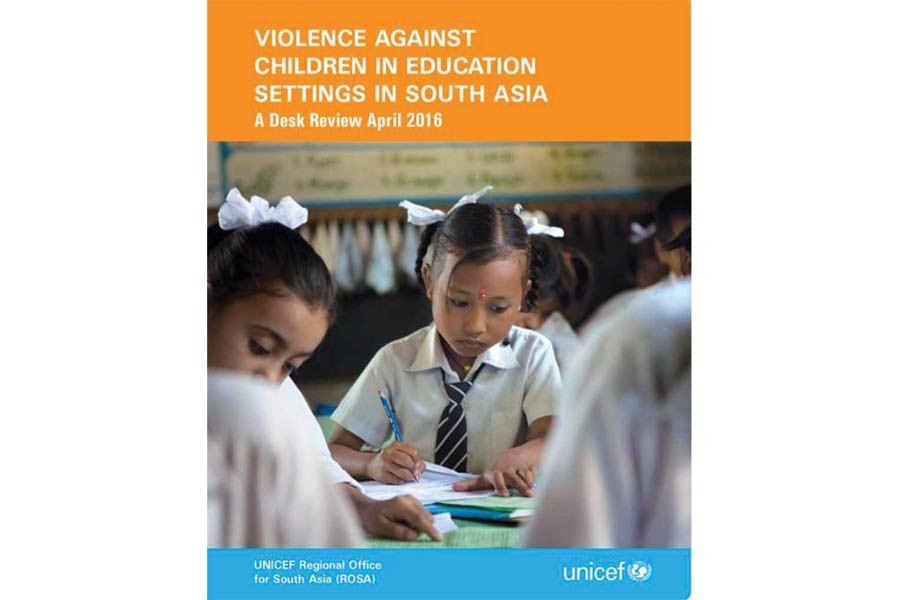Schools are the places where children gain knowledge and skills as well as learn attitudes and behaviour that can shape their relationship with the community. Children's experiences in educational settings have lasting impact on their physical, mental and emotional well-being. Safe and protected learning environments are thus essential for ensuring a healthy future for children of all ages. Without it they are unable to focus on learning the skills needed for a successful education and future. When violence is part of the educational setting, all students are affected in some way. Even though a child may not be the actual victim of violence in school, there is a very good chance that he or she will witness violent acts throughout the educational years. Research continues to illustrate that children who feel unsafe at school perform worse academically and are more at risk of getting involved in drugs and delinquency. The UNICEF publication titled 'Violence against Children in Education Settings in South Asia: A Desk Review' indicates that many children in South Asia are exposed to different forms of violence and threats in schools and other educational settings. This desk study examines the causes and consequences, scale, nature and manifestations of violence against children in education settings in South Asia, as well as reviews regional and country-specific policy and programme responses.
The review focuses on eight countries in South Asia - Afghanistan, Bangladesh, Bhutan, India, Maldives, Nepal, Pakistan and Sri Lanka - where children in education settings experience and witness various forms of violence. Findings show that corporal punishment is the most widely reported form of violence against children (VAC) in education settings. Physical violence, as well as sexual violence, abuse and harassment, are also prevalent in school settings across the region. At the psychological and emotional level, one of the most common forms of violence experienced by school children is bullying. With increased access to the Internet and mobile phone technologies, many children, especially young adolescents, have become vulnerable to a relatively new phenomenon called 'cyber bullying'. Some sources indicate that children in religious schools are not always safe from violence either, though information on VAC in these settings is scarce. The scale of conflict-related VAC in education settings is high or very high in Afghanistan, India and Pakistan, and has also been reported in Nepal and Sri Lanka. Children also experience violence in custody linked with military or armed activities in the region.
Available data reveal a gendered nature of VAC in education settings in South Asia. Boys seem to be more at risk for harsh corporal punishment and physical abuse than girls, while girls are typically more prone than boys to sexual abuse and psychological forms of bullying. The nature and extent of violence experienced by children is also determined by their caste/ethnic identity, economic status, and other markers of vulnerability such as physical disability. South Asia is a deeply hierarchical society where children in many school settings face discrimination based on gender, caste, ethnicity, religion or socio-economic status. Evidence suggests that children from marginalised groups are often more vulnerable to school-based violence - both physical and psychological - than other children. Cultural taboos surrounding sexuality and stigma attached to those who have experienced sexual abuse often prevent cases of sexual violence from coming to light. Accepting attitudes towards violence, combined with the authoritarian structure of schools, allow VAC in education settings to often go unreported. Children are reluctant to report acts of school-related violence because they fear reprisal, punishment, and ridicule.
This well documented desk review argues that VAC in education settings in South Asia needs more attention at the policy and implementation level. To end all forms of violence against children in schools and other education settings this publication provides recommendations: 1) Establishing clear definitions of what constitutes VAC in education settings. These should also include non-physical forms of violence including harassment, bullying or technology-based violence. 2) Addressing the specific vulnerabilities of boys and girls as well as unequal power balance between men and women, boys and girls and different social markers among children in education settings. 3) Scaling up of evidence-based interventions and multiple prevention strategies that influence the likelihood of violence in education settings (e.g., child friendly schools/spaces, teachers' sensitisation/development initiatives, age-relevant sex education and gender-sensitivity/equality initiatives in schools/communities). 4) Conducting research on areas related to VAC in education settings with a particular focus on impact of protection interventions and psychosocial support programmes on children's educational attainment and learning as well as a comprehensive review of school curricula, textbooks and codes of conduct for teachers.
The fifth recommendation emphasises recognising that schools and other education settings are integral parts of the community rather than individually functioning microcosms and promoting positive links between children, parents, teachers, school staff and the broader community. 6) Promoting greater collaboration and coordination with donors and other funding agencies working to address violence against children in education settings in South Asia, and promoting cross-sectoral initiatives.
S.M. Rayhanul Islam is an independent researcher.


